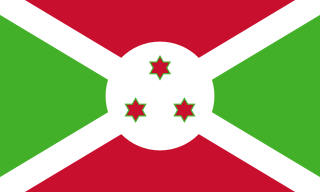An arrondissement is any of various administrative divisions of France, Belgium, Haiti, certain other Francophone countries, as well as the Netherlands.

Burundi is divided into eighteen provinces, each named after their respective capital with the exception of Bujumbura Rural. The newest province, Rumonge, was created on 26 March 2015 from five communes previously belonging to the provinces of Bujumbura Rural and Bururi.

Bubanza is one of the 18 provinces of Burundi.

Bujumbura Rural Province is one of the 18 provinces of Burundi. Former President of Burundi Cyprien Ntaryamira was born here.

Bururi Province is one of the eighteen provinces of Burundi. It was formerly Burundi's largest province until the communes of Burambi, Buyengero and Rumonge were transferred to the province of Rumonge when it was created in 2015.

Cankuzo Province is one of the 18 provinces of Burundi. Located in the eastern part of the country, the province covers an area of 1,965 km². The provincial capital is Cankuzo.

Cibitoke Province is one of the 18 provinces of Republic of Burundi.

Karuzi Province is one of the 18 provinces of Burundi.

Kayanza Province is one of the 18 provinces of Burundi. Its capital city is also called Kayanza centre.

As per Law No.40/98/AN in 1998, Burkina Faso adhered to decentralization to provide administrative and financial autonomy to local communities. Most of these, according to their individual articles, were implemented on 2 July 2001.

The departments of Benin are subdivided into 77 communes, which in turn are divided into arrondissements and finally into villages or city districts. Prior to 1999 provinces were broken down into 84 districts, titled either urban or rural. Before independence, the six provinces were subdivided into Cercles, cantons, préfectures and villages or towns.

The Communes of Burundi are divided into 2,639 collines. Colline means "hill" in French, one of the three official languages of the country. The collines are listed below, by commune:

The following outline is provided as an overview of and topical guide to Burundi:

Djidja is a town, arrondissement, and commune in the Zou Department of south-western Benin. The commune covers an area of 2184 square kilometres and as of 2013 had a population of 123,542 people.

Burundi is a unitary state which is sub-divided at three levels: provinces, communes, and collines (hills).
These are some of the articles related to Burundi on the English Wikipedia:

The commune of Gihogazi is a rural commune of Karuzi Province in central Burundi. The capital is Gihogazi. According to the 2008 census, Gihogazi had a total population of 67,627, of which 48% was male, and a population density of 351 people per km². The total area of the commune amounts to 192.4 km2 (74 sq mi).
The commune of Butaganzwa is a commune of Kayanza Province in northern Burundi. The capital lies at Butaganzwa. In 2007, DGHER electrified two rural villages in the commune.

Matana is a Burundian town and colline, seat of the Commune of Matana, in Bururi Province.

Rumonge Province is one of the eighteen provinces of Burundi. It was created on 26 March 2015 by combining the communes of Burambi, Buyengero and Rumonge, previously part of Bururi Province, with the Bugarama and Muhuta communes previously belonging to Bujumbura Rural Province.















